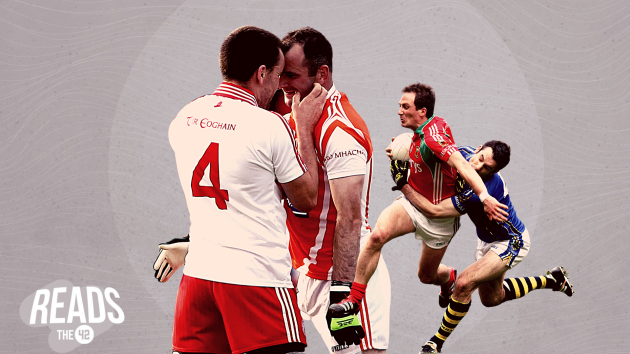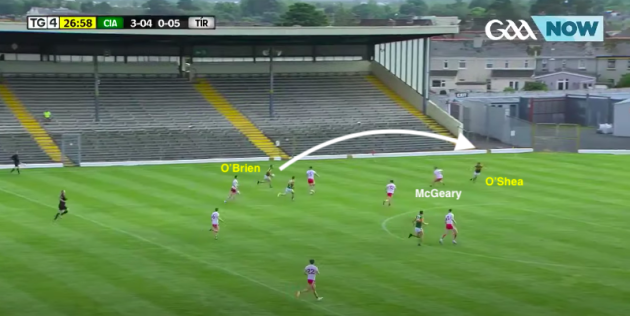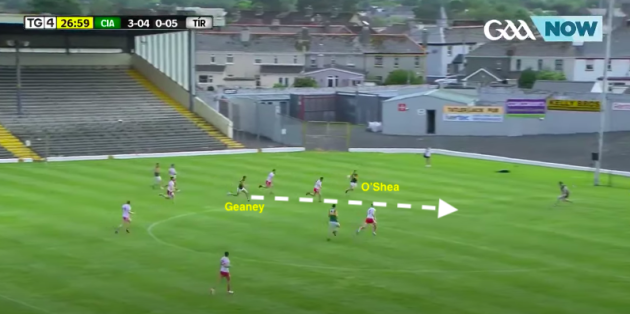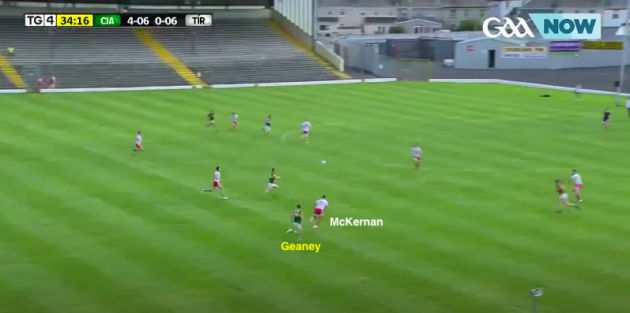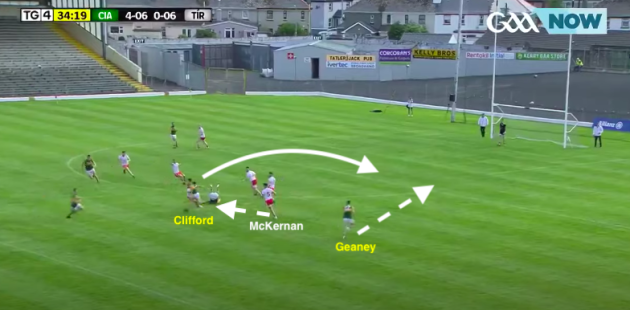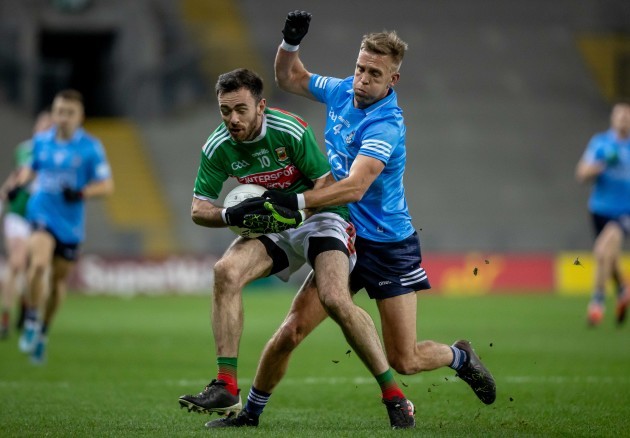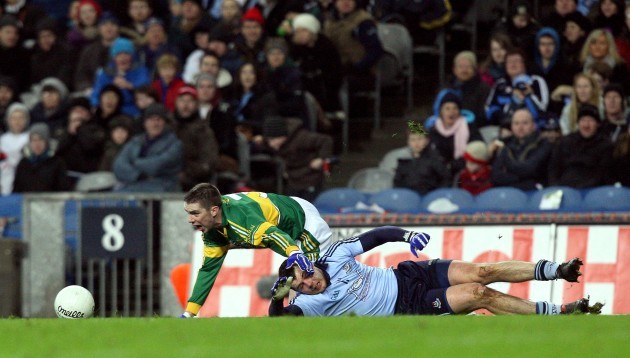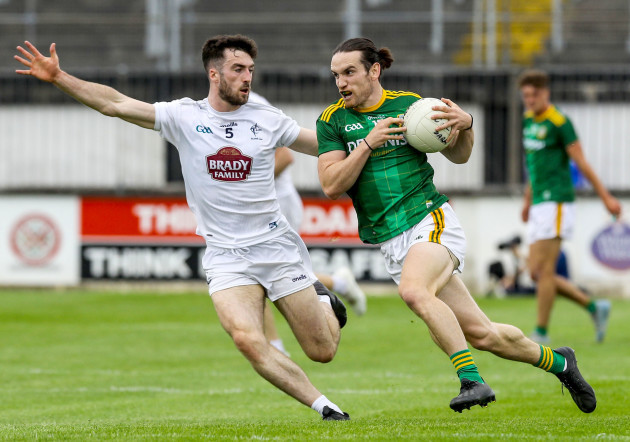“DONEGAL DEFENDERS ARE paying a price for what has gone on before as far as packed defences are concerned,” said Oisin McConville recently. “They’re not in any way comfortable in one-on-one (situations), not at all.
“I understand the rules have some part to play in all this, but I also think the art of defending is nowhere near what it was and that’s as result of the legacy of what has been going on.”
McConville isn’t the only pundit lamenting the dying art of defending. One of the biggest trends to emerge from this year’s league is the idea that specialist man-markers, who are comfortable defending one-on-one, are disappearing from the game.
While Gaelic football appears to be in a very healthy place as the championship kicks off this weekend, many feel the high-scoring games witnessed in the league point to a malaise at the back.
Donegal, Tyrone and Galway have all looked to shift to more attacking styles, yet conceded heavily during the league. Donegal shipped four goals to Monaghan, Tyrone conceded 6-15 against Kerry, and Galway gave up 4-21 against the same opponents.
Dublin and Mayo have long been held up as the only teams who trust their defenders to go one-on-one at the back, but even James Horan’s men conceded 2-18 to Clare in their final league outing.
- For more great storytelling and analysis from our award-winning journalists, join the club at The42 Membership today. Click here to find out more >
“In the league it was lots of shoot-outs because I think fellas were so enthusiastic to get out playing that they just went gung-ho,” says Pat Spillane.
“Is the art of defending gone? I don’t think so. But it’s changed. Five Mayo forwards scored from play against Clare in Ennis and five Mayo backs scored from play as well. 11 out of the (starting) 15 (scored), so that’s the way the game is changing.”
Tyrone are a good example of the teething problems that comes with switching from a zonal to man-on-man defence. Take Paul Geaney’s two goals against the Red Hand in the Division 1 semi-final.
Sean O’Shea finds himself picked up by Kieran McGeary on the half-forward line and uses his game intelligence to bring the Tyrone forward into full-forward – an area where he is uncomfortable defending.
Stephen O’Brien attacks down the flank with McGeary isolated on O’Shea. O’Shea pulls off a simple backdoor cut, which completely takes McGeary out of the game.
The hand-pass goes over McGeary’s head and O’Shea has oceans of space in front of him. He finds the run of Geaney and a simple finish past Niall Morgan gives Kerry their fourth goal.
During the Mickey Harte era, Tyrone would have had extra protection in the form of Colm Cavanagh or a covering defender. But when it’s a man-on-man situation, McGeary cannot afford to make a mistake or it’s a goal.
For Geaney’s second green flag, he pops a ball into David Clifford and continues his run. His marker Michael McKernan is immediately attracted to Clifford as Geaney continues moving towards goal.
Under Tyrone’s previous system, they had a comfort blanket in the full-back line so their defenders could attack the ball and double up on the forward in possession without risking the concession of a goal in behind.
But it takes time to reprogram players, who now must be held accountable for their own man.
Geaney runs ahead and all of a sudden finds himself clean through on goal. The pass arrives from Clifford and the Dingle man drills in Kerry’s fifth.
Tyrone have always been an excellent transition team, but defending in the full-back line is a specialised role. They’re still defending like they have a sweeper playing behind them, so a shift in mentality is required.
Like Galway under Kevin Walsh, Tyrone have been coached for years to defend zonally in numbers, when a risk could be taken to make an interception because a covering defender would generally be nearby.
Most top sides have come to the realisation that the only way to beat Dublin is by outscoring them. But because the majority of teams have been coached in zonal defence over the last decade, there appears to be less specialist man-markers around the place these days.
In addition, the modern game is more fluid and requires defenders to kick scores if they find themselves up the field. Most corner-backs fancy themselves as footballers, are more than capable at carrying out the ball and are not just stoppers anymore.
What happened to the corner-backs whose primary objective was to stop their man, rounded defenders who defended first as a priority and would rather bleed than concede a score?
“The game is definitely turning back to more attack-minded and has done over the last couple of years,” Armagh legend Steven McDonnell says.
“Before that we seen teams going out with ultra-defensive mindsets and when you go out with that mindset sometimes the responsibility is passed out. Players don’t have it in their head as such that they’re man-markers and you lose sight of that. Maybe trying to get that back into the game might take a couple of years.
“There are some good man-markers playing the game at the minute but if you compare it to where the game was 15 or 20 years ago there’s a huge gap there and the game is probably crying out for more specialised man markers.”
The 2002 All-Ireland winner lists Tom O’Sullivan, Ryan McMenamin, Seán Marty Lockhart and Marc Ó Sé among some of the best man-markers he came up against during his career.
But McDonnell sees no issue with corner-backs who attack from deep, once they don’t forget their main role.
“Listen, I actually like a defender who puts a forward on the back foot myself and is quite capable of doing a job (defensively),” he says.
“If you look at Michael Fitzsimons for example, he’s probably the standout candidate at the minute and he’ll try drive forward as much as he possibly can. He doesn’t get into scoring positions, he knows primarily his responsibility is to stop his man but he doesn’t stop there. He does support the Dublin attack as often as he can do as well.
“Marc Ó Sé was an attacking man marker. It’s the type of player who you love to watch. The type that can defend but who can drive forward. He would have been a player who’d mark from the front and would try to cut off the options for a ball being delivered in.
“I always knew when I was marking Marc Ó Sé that I would get a wee bit of space because he didn’t have a hand on me all the time but his pace allowed him get to back and get at me in quick time.
“Sean Marty Lockhart was another one. Yes, first and foremost his primary duty was to stop me but he also put me on the back foot numerous times as well and he could play football. It’s a case of trying to mix and match.
“He liked to be more physical, he was a player something similar to Enda McNulty who liked to have a hand on the chest all the time, be more physical and have contact with his opponent but also have the ability to race and beat him to a ball as well.
“That’s what he had but also when he got the ball he set-up a lot of attacks by maybe offloading a simple fist pass but going and supporting the play.
“That’s a forward’s nightmare: being marked by a corner-back who has confidence in his ability to beat you to the ball but also goes and drives up the field 30, 40 yards because a corner-forward doesn’t want to be doing that, he doesn’t want to be tracking back.”
Along with Fitzsimons, he rates Neil McGee, Jonny Cooper, Donal Keogan and Darren O’Hagan as some of the best stoppers around.
“I think when you’re looking at numbers two, three and four on any team, their main responsibility should be to shut down the danger men that’s playing on the inside line of their opposition.
“Kieran McGeeney always had a great phrase that numbers 1-12 were there to make numbers 13-15 look like superstars and that’s the reality of it. That’s the key to it. If your responsibility is to nullify the threat of 13-15 then that’s what you have to do and that’s your main responsibility.
“It’s not a case that there’s so much emphasis on attacking football at the minute and defending is bad, I think it’s a bit of both. I just think it’s been a case more so over the last number of years there’s been blanket defences and responsibility has been passed about and the onus then on a defender to do his man making duties probably has been less than what it had been before.”
It’s no surprise that six-in-a-row All-Ireland champions Dublin set the benchmark in terms of capable man-markers.
The defensive class of Fitzsimons, Cooper, Cian O’Sullivan, Davy Byrne and Philly McMahon gave Dublin’s star-studded forwards the platform to showcase their skills up front.
For former Donegal boss Jim McGuinness, an elite defender at inter-county level needs pace and athleticism to deal with one-on-one match-ups.
“I think a lot of it is down to your own attributes as a defender,” he explains.
“If you’re not quick and you’re not agile and you’re not strong, then you’re going to struggle regardless. So it’s really down to the physique and the athleticism and the fast-twitch fibres for a lot of these defenders.
“That’s why Dublin have been so good, they can go and play that game because all of their defenders are probably as big if not bigger and stronger and faster than any of the teams they come up against,” McGuinness continues.
“That’s why they’ve become the benchmark. And they’ve got depth. They’ve got nine or ten players that can play in any of those positions.
“Water will always find the easiest course to the ocean and good teams will find a way to find a weak link and ask those questions in those situations now. We’ve seen that through the course of the league.
“Controlling transitional moments, getting the ball in the hands of the quickest players and then how players deal with that. But it’s almost impossible to deal with it if you get isolated.
“A really quick player drops his shoulder and goes in another direction, I’m not sure what you can do in that situation other than the fact that you’re quicker than him and can recover back in, you’re not going to catch him.”
Despite all their attacking prowess during the league, significant question marks hang over Kerry’s defence. In particular, finding a man-marker capable shutting down Con O’Callaghan or Ciaran Kilkenny appears to be Peter Keane’s major concern heading into the championship.
Under Jack O’Connor, they boasted O’Sullivan, Mike McCarthy and Ó Sé, who comfortably defended one-on-one in oceans of space. Then Aidan O’Mahony arrived on the scene and could perform similar duties on the half- or full-back lines.
And while the Kingdom put up tallies of 4-21, 1-18, 2-15 and 6-15 in their four league games this year, it’s at the back where question marks remain.
“If you’re playing a zonal or mass defence, sure you’re not responsible for marking,” says Spillane.
“That was one of the problems when Kerry did the zonal defence against Dublin. Niall Scully had the running of the field in the first-half and no-one seemed to know who was on him.
“I keep saying this about football, right (you can say), ‘Oh the game is evolving, it’s changing’ but the basic principles haven’t changed. When you’re without the ball you’re a defender and responsible for one man, when you’re with the ball you’re an attacker. The only thing is what defenders have become, maybe you’re right.
“And this is what Kerry lack. Kerry have beautiful footballers as defenders but maybe we lack the dog. In my time we had Páidí Ó Sé, Tim Kennelly, Jimmy Deenihan and by Jesus they were man-markers. They were physical.
“The Kerry team of the noughties had Marc Ó Sés and Aidan O’Mahonys. We don’t have them, we’re not going to find one now. We’re not going to go zonal, we’re going to just have to work hard.”
Other factors are also in play. The rules are heavily weighed against defenders.
The new cynicism rule that sees a penalty and black card awarded for a cynical foul which denies a goal-scoring opportunity inside the 20m line, might mean backs are reluctant to get involved physically close to goal.
The advanced mark encourages corner-backs to take more risks to prevent the forward from being given an easy shot at the posts. If they misjudge the flight of the ball, an attacker can get in behind for a goal.
Referees often allow forwards over carry the ball if they’re being fouled, while there’s still no proper definition of the tackle.
Or is it a case that forwards are simply getting better?
As a result of playing against packed defences for so long, attackers have become accustomed to operating in tight spaces. Now with the game opening up and an extra few yards on offer, they’re making hay.
McDonnell says Dublin have led the way in an attacking sense and showed others how to create scoring opportunities against blanket defences.
“If you look at Dublin they drag teams all over the forward area, they create a wee pocket of space and their movement is better than any other team,” he explains. “That’s how they’re able to open teams up.
“They make checked runs, diagonal runs, runs into space to create space for their team-mates. They probably think a wee bit better than every other team at the minute. That’s what creates openings for Dublin is their intelligent running and creating that space and their awareness of their team-mates around them.
“Any team that’s coached right can certainly create pockets of space regardless of how many players are back. Also if you penetrate your opponent with a wee bit of pace, if you’ve players playing off the shoulder then that definitely causes headaches as well but not enough teams take those risks.”
For McGuinness, the issue of defending will be one of the major themes in the 2021 championship.
“It’s going to be a big talking point, there’s no doubt about that,” he predicts. “It’s going to be a really big talking point.
“So how that plays out I think is one of the most intriguing parts of what could be coming down the track for this championship.”
For more great storytelling and analysis from our award-winning journalists, join the club at The42 Membership today. Click here to find out more >
